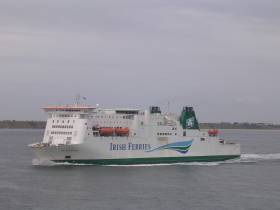Displaying items by tag: 2018: 21st year of service
Cruiseferry Isle of Inishmore Enters 21st Year of Service
#FerryNews - Following last week's hull launch of ICG's biggest cruiseferry W.B. Yeats in Germany, Isle of Inishmore completed a routine annual overhaul and departed a drydock in the UK on Monday, writes Jehan Ashmore.
Afloat adds the Isle of Inishmore today made a first sailing in 2018, a year that will mark 21 years of service for Irish Continental Group (ICG) the parent company of operator Irish Ferries.
ICG placed the order for Isle of Inishmore with Van der Giessen-de Noord shipyard in The Netherlands and entered service on the Dublin-Holyhead route in 1997. Then easily the largest ever ferry to operate the Ireland-Wales route having replaced a smaller cruiseferry, Isle of Innisfree. That was ICG's first custom-built ferry when launched into service only two years previously.
Demand for more freight capacity during the run up to the Celtic Tiger era led to this second much larger cruiseferry from the same Dutch shipbuilders. The yard located in Krimpen aan de Ijssel, Rotterdam, however has since closed.
At 34,031 gross tonnage, Isle of Inishmore with a capacity for 2,200 passengers/ 800 cars and 150 trucks, remains after two decades, the second largest ferry (after Ulysses), currently serving between Ireland and the UK.
The 1,875 passenger flagship Ulysses with vehicle space for 1,342 cars and 330 trucks was introduced in 2001 and replaced Isle of Inishmore from the Dublin service. This morning, the cruiseferry resumed sailings for the first time this year on the Rosslare-Pembroke route.
The Dutch built Isle of Inishmore which has an extensive range of passenger facilities, continues to be the largest cruiseferry in terms of passenger capacity operating in north-western Europe.
Afloat had previously tracked Isle of Inishmore from the drydock facility of Cammell Laird in Birkenhead on Merseyside and which led to an arrival to Dublin Port on Monday. The call to the capital was brief as the cruiseferry completed the repositioning voyage to Rosslare Harbour yesterday.
While Isle of Inishmore was off-service on the south Wales route, sailings were covered by Oscar Wilde. Previously, the cruiseferry provided additional capacity over the festive /new year season on the Dublin route. In recent days, however sailings on the Rosslare route were cancelled due to adverse weather conditions.
Also this morning, Afloat tracked Oscar Wilde having rounded Anglesey, north Wales and is bound for Birkenhead to also undergo routine drydocking. At this quite time of year, Irish Ferries Jonathan Swift is already at the drydock facility having completed fastferry crossings on the Dublin-Holyhead route.






























































